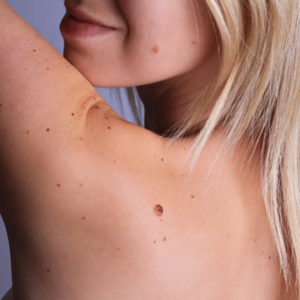New York City and Manhattan, NY
Moles are mostly normal skin occurrences that do not require extensive treatment. Often small, slightly darker spots, moles can appear anywhere on the body. They are not skin tone specific, so they may develop on anyone. But, how do you know when a mole is cause for concern? Today on the blog, our board-certified dermatologists in Manhattan, Drs. Debra Wattenberg and Ilyse Lefkowicz, are addressing this common question.
What is a mole?

Moles, medically referred to as nevis, are perfectly normal skin conditions and are created when skin cells grow in clusters versus spreading out. Typically, moles are harmless and cause no health concerns. However, some moles can turn cancerous, which causes a high level of concern and will require removal of the mole, along with any cancerous cells.
What is the difference between common moles and atypical moles?
As stated previously, most moles are harmless. Common moles are less likely to become cancerous, but there is a heightened risk for cancer if you have more than fifty moles on your body.
Common moles can be flat or appear as a little bump on your skin. Most normal moles are tan, brown, skin-toned, blue, red, translucent, or pink that are smaller than a quarter of an inch or five millimeters in diameter. The common mole is often shaped like a circle, even on both sides, and has a distinct border that distinguishes it from the surrounding skin.
Atypical moles share the same quality of being flat or raised from the skin. However, atypical moles measure more than a quarter of an inch or six millimeters in diameter. They are irregularly shaped where the border fades into your natural skin tone surrounding the mole. Appearing in various combinations of colors, the surface of an atypical mole can be smooth, rough, flaky, uneven, or bumpy.
Why would a mole be itchy, but not painful?
There are several reasons why a mole may itch and not be painful. Itchy moles rarely are cancerous. When your nerves are irritated, they can cause itching. The itching could then be caused by chemicals that are in products you use on your skin, peeling skin from a sunburn, or dry skin. However, sometimes when a mole itches, it could be a sign of things transforming into something else and requires your immediate attention.
What are the treatment options for an itchy mole?
When you have a mole that itches, changes in size, color, or shape, it is time to consult a dermatologist to ensure the mole is not cancerous. If the mole feels tender, bleeds, or becomes painful, it is critical to visit your physician immediately.
What are the signs of a malignant mole?
A malignant mole is one that is cancerous. Certain signs indicate whether a mole is malignant. The ABCDE method can sum up the signs:
- Asymmetry – One side of the mole is different from the other
- Border – The border of the mole is irregular, ragged, or blurred
- Color – There is more than one distinct color
- Diameter – The mole is larger than a quarter of an inch or six millimeters in diameter
- Elevating/Evolving – The mole changes in color, shape, size, or is raised above the skin surface
If any of these signs are evident when assessing your skin, it is time to see your dermatologist for an examination.
Can skin cancer cause itching?
The most common skin cancers are basal cell carcinoma (BCC) and squamous cell carcinoma (SCC), both conditions can be treatable. In the cases where patients have had BCC or SCC, approximately forty percent have experienced itching, but the itching has ceased once the cancer is removed. The deadliest form of skin cancer, melanoma, rarely causes the skin to itch. But, you can never be too sure! It is always best to consult with a dermatologist regarding any changes in your skin or moles.
When bathing or changing clothes, take an extra minute to examine your moles. If you see one that is changing or you have additional concerns, feel free to contact NY Skin RX at (212) 288-3200 for a skin cancer screening in Manhattan or New York City.
